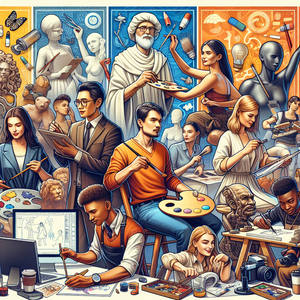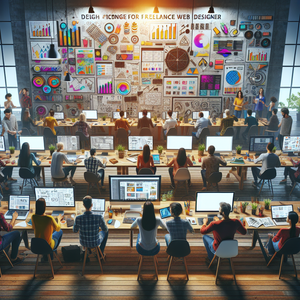
Exploring the Creative Spectrum: A Comprehensive Guide to 20 Unique Careers in Art
The realm of art is a colorful and dynamic world, brimming with diverse career paths for those with a passion for creativity. From traditional mediums like painting and sculpture to innovative fields such as digital art and multimedia design, the possibilities for artistic expression are virtually endless. This guide delves into a variety of artistic careers, shedding light on the essential skills, techniques, and current trends that define each field. By exploring roles ranging from fine artists to graphic designers and photographers, we aim to inspire aspiring creatives to discover their own unique paths. Whether your passion lies in crafting stunning installations, narrating stories through photography, or venturing into the digital domain, this article offers valuable insights into specific artistic roles, their responsibilities, educational prerequisites, and the evolving job market.
Job Summaries:
Painter:
- Painters use mediums such as oil, acrylic, and watercolor to convey their artistic visions.
- Responsibilities include brainstorming concepts, preparing surfaces, and applying paint to express emotions and themes.
- While a degree in fine arts can be advantageous, a robust understanding of color theory and composition is crucial.
- Painters play a vital role in cultural dialogues, often showcasing their work in exhibitions.
- For those eager to begin their artistic journey, job openings in this field are readily available.
Sculptor:
- Sculptors create three-dimensional works using materials like clay, stone, metal, and wood.
- Their tasks involve designing, carving, molding, and assembling pieces, requiring both traditional and contemporary techniques.
- A background in fine arts or sculpture, along with anatomical knowledge, can enhance one’s skill set.
- Sculptors add a tangible dimension to art, making their creations essential for galleries and public art installations.
- Explore opportunities to start your sculptural journey.
Photographer:
- Photographers capture images that tell stories or evoke emotions.
- They manage composition, lighting, and post-processing.
- A degree in photography or visual arts is often helpful.
- Proficiency in editing software is beneficial.
- Photographers are key players in visual storytelling across various fields.
- These fields include fashion, journalism, and fine arts.
- Numerous job openings await for those passionate about photography.
Graphic Designer:
- Graphic designers merge art and technology to visually convey ideas.
- They develop layouts for both digital and print media, utilizing software like Adobe Creative Suite.
- Typically, a bachelor’s degree in graphic design or a related field is required, coupled with strong creative and technical abilities.
- Designers are instrumental in branding and marketing, assisting businesses in effectively communicating their messages.
- Interested individuals can explore graphic design positions that resonate with their artistic vision.
Illustrator:
- Illustrators create images that complement text or communicate concepts through visual narratives.
- Their work spans books, magazines, advertisements, and digital platforms.
- Mastery of drawing and digital illustration software is essential, along with a diverse portfolio.
- A degree in illustration or fine arts can be beneficial.
- Illustrators enhance narratives and advertisements, making their creativity indispensable to publishers and brands.
Printmaker:
- Printmakers focus on producing artwork through techniques such as lithography, etching, and screen printing.
- Their duties involve creating designs, preparing printing plates, and executing prints.
- Training in fine arts or printmaking is essential, alongside a keen eye for detail.
- Printmakers significantly contribute to both fine art and commercial projects, making their work vital in galleries and product design.
Collage Artist:
- Collage artists create artworks by assembling various materials, including photographs, paper, and fabric.
- They explore texture, color, and form to express intricate ideas or emotions.
- A background in fine arts or mixed media is beneficial, along with an innovative mindset.
- Collage artists frequently engage in exhibitions and workshops, adding to the lively nature of contemporary art.
Digital Artist:
- Digital artists harness technology to create art using software for illustrations, animations, and graphic designs.
- Familiarity with digital platforms and a solid grasp of composition and color are essential.
- A degree in digital arts or graphic design is often preferred.
- Digital artists are crucial in advertising, gaming, and multimedia projects, pushing the boundaries of traditional art forms.
Tattoo Artist:
- Tattoo artists design and apply permanent body art.
- They blend artistic talent with technical expertise in skin and tattooing methods.
- Maintaining a sterile environment and ensuring client safety are paramount.
- Certification in health protocols is often necessary.
- Formal education isn't always required.
- A strong portfolio showcasing creativity and precision is vital.
Art Director:
- Art directors oversee the visual components of creative projects.
- Managing teams to ensure consistent branding and messaging.
- Responsibilities include conceptualizing designs, planning project timelines, and reviewing artwork for quality.
- A degree in art, design, or a related field is typically required.
- Robust leadership and communication capabilities are essential.
Multimedia Artist:
- Multimedia artists create visual content by blending traditional art with digital techniques.
- Often working on animations, video games, and interactive installations.
- Proficiency in various software and a strong foundation in art principles are critical.
- A degree in multimedia arts or animation is often advantageous.
Fashion Designer:
- Fashion designers combine aesthetics with functionality to create clothing and accessories.
- Their tasks include sketching designs, selecting fabrics, and overseeing production.
- A degree in fashion design is essential, along with a strong sense of style and trend awareness.
Ceramic Artist:
- Ceramic artists craft functional and decorative items from clay.
- They use techniques like throwing, hand-building, and glazing.
- A background in ceramics or fine arts can be helpful.
- Hands-on experience is important for ceramic artists.
- Ceramic artists often showcase their work in galleries and craft fairs.
Calligrapher:
- Calligraphers specialize in beautiful handwriting.
- Creating custom designs for invitations, signage, and artwork.
- Mastery of various styles and techniques is essential.
- Requires patience and precision.
- A strong portfolio is critical for demonstrating their skills.
Set Designer:
- Set designers create physical environments for performances, films, and photo shoots.
- They transform scripts into visual settings.
- A degree in theater design is often necessary.
- Strong spatial awareness is important.
- Creative problem-solving abilities are essential.
Art Conservator:
- Art conservators focus on preserving and restoring artworks.
- Requires a deep understanding of art history and conservation techniques.
- A degree in art conservation is essential.
- Analytical skills are needed to evaluate the condition of pieces.
Film Director:
- Film directors manage the creative aspects of film production.
- They guide the artistic vision and oversee cast and crew.
- A background in film studies is often beneficial.
- Strong leadership and communication skills are important.
Art Educator:
- Art educators teach various art forms
- Developing lesson plans
- Inspiring creativity in students
- A degree in art education is typically required
- Along with teaching certification
Textile Designer:
- Textile designers create patterns for fabrics used in fashion and home décor.
- Their responsibilities include researching trends, crafting original patterns, and collaborating with manufacturers.
- A degree in textile design is often necessary.
Performance Artist:
- Performance artists utilize their bodies, voices, and actions to convey artistic expressions, often in live settings.
- A background in performing arts is advantageous, alongside strong improvisational skills.
The descriptions above highlight the diverse paths available within the art world, catering to a variety of interests and skills. As the industry continues to evolve, new trends and technologies are shaping the future of artistic careers. Aspiring artists can find their place in this rich landscape by exploring these roles, considering educational requirements, job market conditions, and potential salary expectations. For those eager to learn more about job opportunities in these artistic fields, numerous resources and industry organizations are available to guide your journey. Embrace your creativity and take the first step toward a fulfilling career in the arts today!
Explore More Jobs

